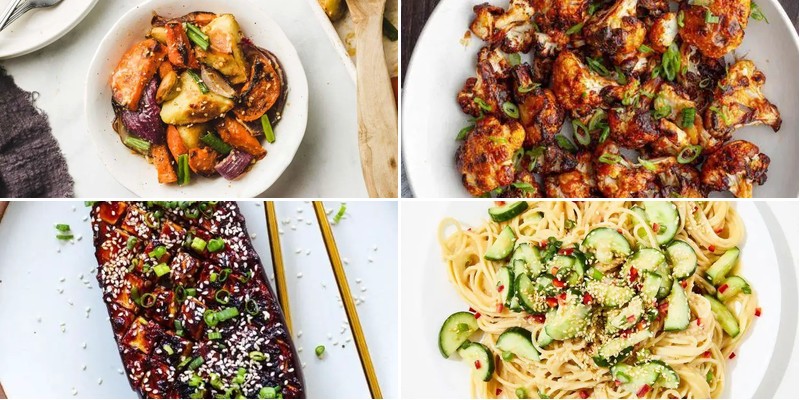Ready to elevate your cooking with the savory magic of white miso? This versatile Japanese staple adds incredible umami depth to everything from quick weeknight dinners to elegant comfort dishes. Whether you’re a miso newbie or a seasoned pro, these 27 delicious recipes will inspire your kitchen adventures and satisfy your cravings. Let’s dive into these mouthwatering creations you’ll want to make again and again!
White Miso and Garlic Ramen
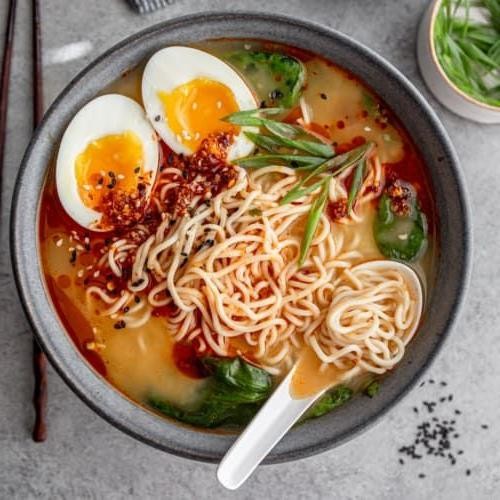
Sometimes, the most comforting meals emerge from quiet afternoons when the kitchen becomes a sanctuary, and today’s gentle simmer of white miso and garlic feels like a whispered promise of warmth. Soft steam rises from the pot, carrying the earthy scent of fermented soybean paste and the sharp, aromatic punch of fresh garlic, mingling together in a broth that asks for nothing more than your patience and presence. This simple ramen is less about precision and more about the slow, mindful process of building layers of flavor, one ingredient at a time, until everything comes together in a bowl that feels like a hug from the inside out.
2
servings10
minutes20
minutesIngredients
– 2 tablespoons rich toasted sesame oil
– 4 cloves aromatic fresh garlic, minced
– 2 tablespoons savory white miso paste
– 4 cups rich chicken or vegetable broth
– 6 ounces fresh ramen noodles
– 2 large farm-fresh eggs
– 2 tablespoons delicate soy sauce
– 1 teaspoon finely ground black pepper
– 2 stalks crisp green onions, thinly sliced
Instructions
1. Heat 2 tablespoons of rich toasted sesame oil in a large pot over medium heat until it shimmers lightly, about 1 minute.
2. Add 4 cloves of minced aromatic fresh garlic to the pot and sauté until fragrant and golden, stirring constantly for 2 minutes to prevent burning.
3. Whisk 2 tablespoons of savory white miso paste into the garlic and oil until fully incorporated and smooth, about 30 seconds.
4. Pour 4 cups of rich chicken or vegetable broth into the pot, stirring to combine all ingredients thoroughly.
5. Bring the broth to a gentle boil over high heat, then reduce to a simmer and cook uncovered for 10 minutes to allow the flavors to meld.
6. While the broth simmers, fill a separate medium pot with water and bring to a rolling boil over high heat.
7. Carefully lower 2 large farm-fresh eggs into the boiling water and cook for exactly 7 minutes for a soft, jammy yolk.
8. Immediately transfer the cooked eggs to an ice water bath using a slotted spoon and let them cool for 3 minutes to stop the cooking process.
9. Add 6 ounces of fresh ramen noodles to the same boiling water and cook according to package instructions, typically 3–4 minutes, until tender but still chewy.
10. Drain the noodles thoroughly in a colander and divide them evenly between two large bowls.
11. Peel the cooled soft-boiled eggs and slice them in half lengthwise to reveal the creamy yolk.
12. Stir 2 tablespoons of delicate soy sauce and 1 teaspoon of finely ground black pepper into the simmering broth until well blended.
13. Ladle the hot broth over the noodles in each bowl, ensuring they are fully submerged.
14. Top each bowl with two halves of the soft-boiled egg and a generous sprinkle of thinly sliced crisp green onions. You’ll find the broth has a velvety richness from the miso, with the noodles offering a satisfying chew against the creamy egg yolk. For a vibrant twist, try serving it with a side of quick-pickled radishes or a drizzle of chili oil to cut through the umami depth, making each spoonful a quiet celebration of texture and warmth.
White Miso Marinated Salmon
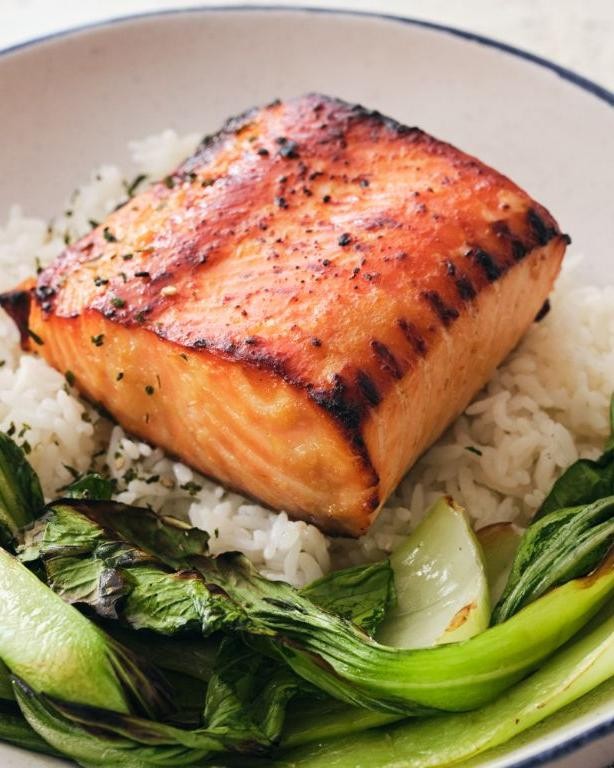
Perhaps there’s something quietly magical about how simple ingredients can transform into something so deeply comforting, how the gentle umami of white miso can cradle the richness of salmon into a dish that feels both nourishing and celebratory.
3
servings35
minutes11
minutesIngredients
- 4 (6-ounce) skin-on salmon fillets with their vibrant coral hue
- 1/4 cup smooth white miso paste with its gentle fermented aroma
- 2 tablespoons pure maple syrup with its deep amber sweetness
- 1 tablespoon freshly squeezed lemon juice, bright and tangy
- 1 tablespoon rich toasted sesame oil
- 1 teaspoon finely grated fresh ginger root, spicy and aromatic
- 1/4 teaspoon freshly cracked black pepper
- 1 tablespoon fragrant neutral oil like avocado or grapeseed
- 2 tablespoons thinly sliced fresh scallions with their crisp green tops
- 1 teaspoon toasted white sesame seeds
Instructions
- Pat the salmon fillets completely dry with paper towels to ensure a crisp skin.
- Whisk together the white miso paste, maple syrup, lemon juice, toasted sesame oil, grated ginger, and black pepper in a medium bowl until perfectly smooth.
- Place the salmon fillets in a shallow dish and coat them evenly with the miso marinade.
- Cover the dish tightly with plastic wrap and refrigerate for exactly 30 minutes—no longer, as the acid can begin to “cook” the fish.
- Preheat your oven to 400°F and place a rack in the center position.
- Heat the neutral oil in a large oven-safe skillet over medium-high heat until it shimmers.
- Place the salmon fillets skin-side down in the hot skillet and sear undisturbed for 3 minutes to create a golden crust.
- Transfer the entire skillet to the preheated oven and bake for 6-8 minutes, until the salmon flakes easily with a fork but remains moist in the center.
- Remove the skillet from the oven using a dry oven mitt—remember the handle will be extremely hot.
- Let the salmon rest in the skillet for 2 minutes before serving to allow the juices to redistribute.
- Sprinkle with sliced scallions and toasted sesame seeds just before serving.
Underneath that caramelized miso glaze, the salmon becomes impossibly tender, flaking into pearlescent petals at the slightest pressure. The gentle sweetness plays beautifully against the savory depth, creating layers of flavor that unfold slowly with each bite. I love serving it over a bed of jasmine rice to catch every drop of the glossy sauce, with steamed bok choy on the side for a complete, comforting meal.
Roasted Vegetables with White Miso Glaze
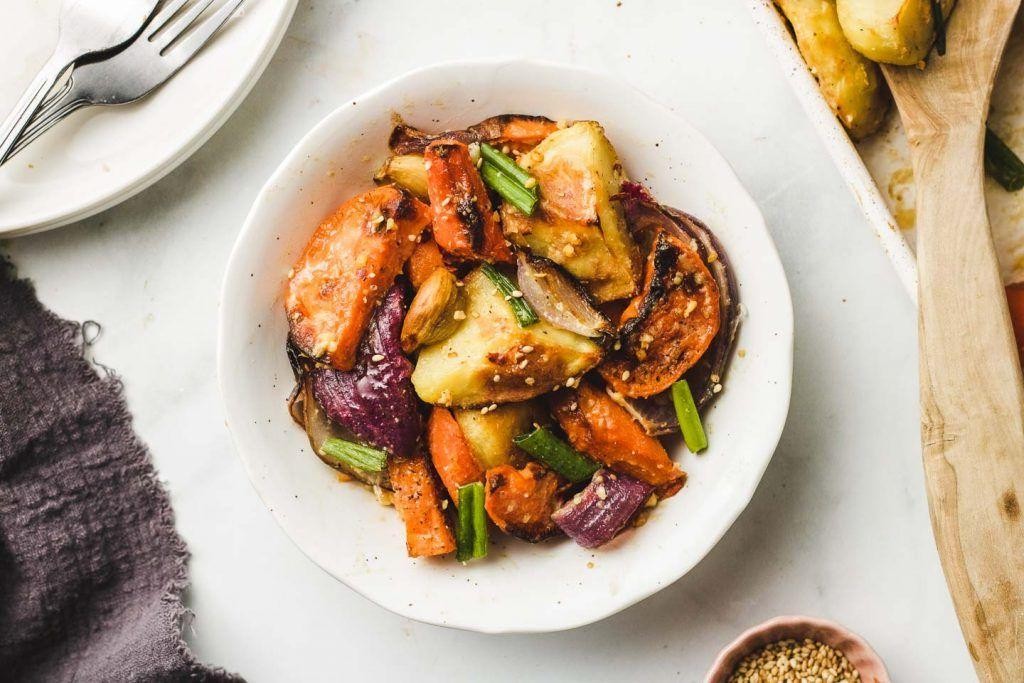
Just now, as afternoon light slants across the kitchen counter, I find myself reaching for the familiar comfort of roasting pans and mixing bowls. There’s something quietly grounding about transforming humble vegetables into a dish that feels both nourishing and deeply flavorful. Today, it’s roasted vegetables with a white miso glaze—a simple preparation that never fails to soothe the soul.
5
servings15
minutes32
minutesIngredients
– 1 pound of vibrant, seasonal root vegetables (such as carrots, sweet potatoes, and parsnips), cut into 1-inch chunks
– 2 tablespoons of rich extra virgin olive oil
– 1/4 cup of smooth white miso paste
– 2 tablespoons of pure maple syrup
– 1 tablespoon of fresh lemon juice
– 1 teaspoon of toasted sesame oil
– 1/4 teaspoon of finely ground black pepper
– 2 tablespoons of warm water
– 1 tablespoon of toasted sesame seeds for garnish
– 2 tablespoons of freshly chopped scallions for garnish
Instructions
1. Preheat your oven to 425°F and line a large baking sheet with parchment paper.
2. In a large mixing bowl, toss the 1-inch vegetable chunks with 2 tablespoons of rich extra virgin olive oil until evenly coated.
3. Spread the oiled vegetables in a single layer on the prepared baking sheet, ensuring they aren’t crowded.
4. Roast the vegetables in the preheated oven for 20 minutes, until they begin to soften and edges turn golden.
5. While the vegetables roast, whisk together 1/4 cup of smooth white miso paste, 2 tablespoons of pure maple syrup, 1 tablespoon of fresh lemon juice, 1 teaspoon of toasted sesame oil, and 1/4 teaspoon of finely ground black pepper in a small bowl.
6. Gradually add 2 tablespoons of warm water to the miso mixture, whisking continuously until the glaze is smooth and pourable.
7. After 20 minutes of roasting, remove the baking sheet from the oven and brush the vegetables evenly with the prepared miso glaze.
8. Return the glazed vegetables to the oven and roast for an additional 10–12 minutes, until the glaze is caramelized and vegetables are tender when pierced with a fork.
9. Transfer the roasted vegetables to a serving platter and sprinkle with 1 tablespoon of toasted sesame seeds and 2 tablespoons of freshly chopped scallions.
You’ll love the way the sticky, savory-sweet glaze clings to each vegetable chunk, creating a glossy sheen that promises depth in every bite. Serve them warm over a bed of fluffy quinoa or alongside seared tofu for a complete meal that feels both rustic and refined.
White Miso Soup with Tofu and Seaweed
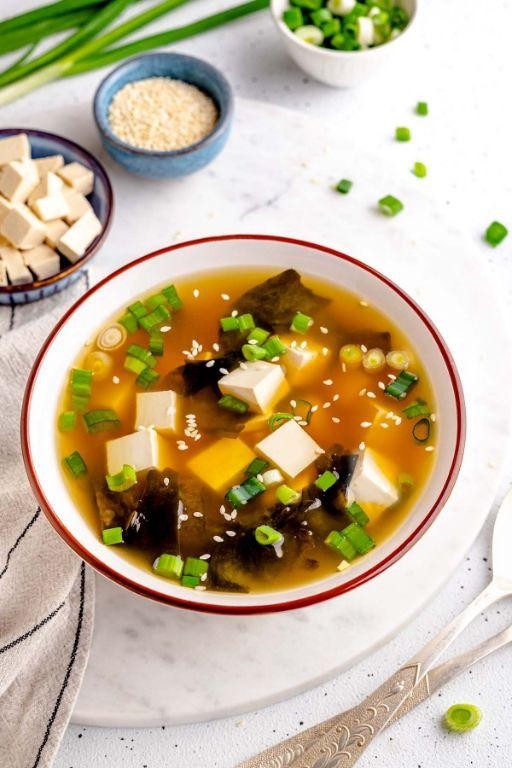
Perhaps there’s something quietly comforting about watching steam rise from a simple bowl, the way it carries scents of the sea and earth into the quiet kitchen air. It’s in these small, simmering moments that a humble pot of soup can feel like a gentle pause, a warm whisper against the chill of the day.
4
servings10
minutes15
minutesIngredients
- 4 cups cold, filtered water
- 1/4 cup delicate white miso paste
- 1/2 block of soft, silken tofu, cut into 1/2-inch cubes
- 1/4 cup dried wakame seaweed
- 2 thinly sliced fresh green onions
Instructions
- Pour 4 cups of cold, filtered water into a medium saucepan and place it over medium-high heat until small bubbles form around the edges, about 5-7 minutes.
- Reduce the heat to low and carefully ladle about 1/2 cup of the hot water into a small bowl.
- Add 1/4 cup of delicate white miso paste to the bowl and whisk vigorously until completely smooth and free of lumps.
- Tip: Whisking the miso separately prevents clumps and ensures a silky, even broth.
- Gently pour the dissolved miso mixture back into the saucepan, stirring continuously with a wooden spoon.
- Add 1/2 block of soft, silken tofu, cut into 1/2-inch cubes, to the broth and let it warm through for 2 minutes without stirring to keep the tofu intact.
- Sprinkle in 1/4 cup of dried wakame seaweed and let it soak and expand for exactly 3 minutes until tender and vibrant green.
- Tip: Avoid boiling the soup after adding miso to preserve its delicate, probiotic qualities and subtle flavor.
- Remove the saucepan from the heat and stir in 2 thinly sliced fresh green onions just before serving.
- Tip: For the best texture, serve immediately while the seaweed is still slightly firm and the tofu is warm but not breaking apart.
The broth settles into a cloudy, golden embrace, holding cubes of tofu that yield like soft clouds against the spoon. Each sip carries the gentle saltiness of the sea from the wakame, balanced by the mellow sweetness of white miso, making it perfect for sipping slowly from a deep ceramic bowl on a quiet evening.
Grilled Chicken Thighs with White Miso Sauce
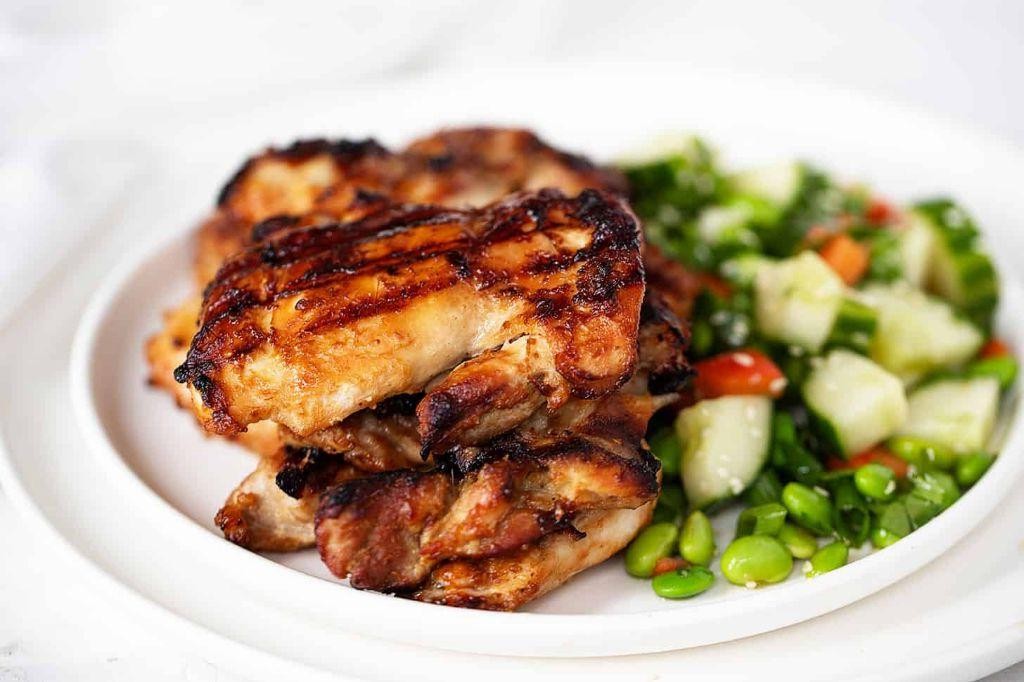
A quiet afternoon finds me returning to this simple comfort, the kind of meal that feels like a gentle exhale after a long day, where the sizzle of chicken thighs on the grill and the sweet, savory scent of miso promise a deeply satisfying stillness.
2
portions25
minutes15
minutesIngredients
– 1 ½ pounds bone-in, skin-on chicken thighs
– ¼ cup white miso paste
– 2 tablespoons smooth, golden honey
– 1 tablespoon rich, toasted sesame oil
– 2 tablespoons fresh, tangy rice vinegar
– 1 tablespoon finely grated fresh ginger root
– 2 cloves aromatic garlic, minced
– ½ teaspoon finely ground black pepper
– ¼ cup cool water
– 2 tablespoons thinly sliced fresh scallions
– 1 tablespoon toasted white sesame seeds
Instructions
1. Pat the 1 ½ pounds of bone-in, skin-on chicken thighs completely dry with paper towels to ensure crisp skin.
2. In a small bowl, whisk together the ¼ cup of white miso paste, 2 tablespoons of smooth, golden honey, 1 tablespoon of rich, toasted sesame oil, 2 tablespoons of fresh, tangy rice vinegar, 1 tablespoon of finely grated fresh ginger root, 2 cloves of minced aromatic garlic, and ½ teaspoon of finely ground black pepper until a smooth, thick sauce forms.
3. Reserve half of the miso sauce in a separate small bowl for serving later.
4. Brush the remaining half of the miso sauce evenly over all sides of the dried chicken thighs, coating them thoroughly.
5. Let the coated chicken thighs marinate at room temperature for 20 minutes to allow the flavors to penetrate.
6. Preheat an outdoor grill or grill pan to a steady medium heat of 375°F.
7. Place the marinated chicken thighs skin-side down on the preheated grill grates.
8. Grill the chicken thighs for 7-8 minutes on the skin side until deep golden-brown grill marks form and the skin is crisp.
9. Flip the chicken thighs carefully using tongs.
10. Continue grilling the chicken thighs for another 6-7 minutes on the second side until the internal temperature reaches 165°F when checked with an instant-read thermometer inserted into the thickest part, avoiding the bone.
11. Transfer the grilled chicken thighs to a clean plate or cutting board to rest for 5 minutes, which allows the juices to redistribute for a more tender bite.
12. Thin the reserved miso sauce with ¼ cup of cool water, stirring until it reaches a pourable consistency.
13. Drizzle the thinned miso sauce over the rested chicken thighs.
14. Garnish the finished dish with 2 tablespoons of thinly sliced fresh scallions and 1 tablespoon of toasted white sesame seeds. Here, the chicken emerges with a crackling, lacquered skin that gives way to impossibly juicy meat, each bite layered with the deep umami of miso and a subtle, sweet warmth from the ginger. I love serving it over a bed of steaming jasmine rice to catch every drop of the glossy sauce, or shredding it into a cool, crisp cabbage slaw for a textural contrast that feels both nourishing and new.
White Miso and Ginger Stir-Fried Vegetables
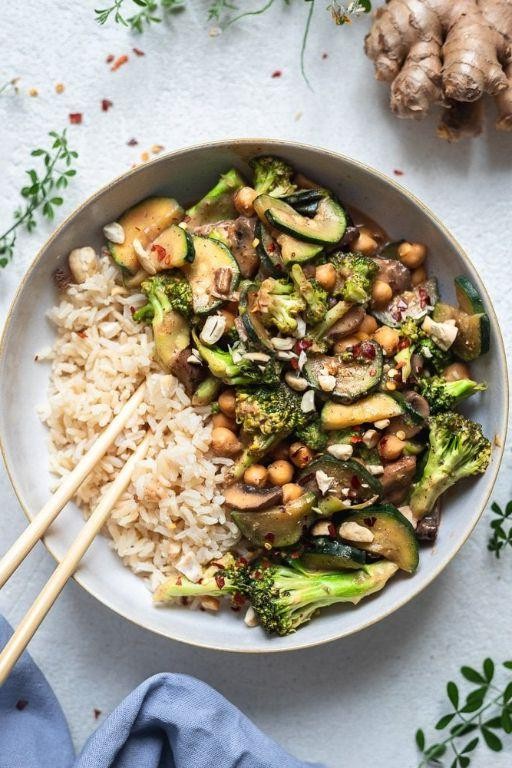
Sometimes the most comforting meals emerge from the quiet moments in the kitchen, when the gentle sizzle of vegetables meeting a hot pan becomes a kind of meditation. This stir-fry, with its warm notes of white miso and fresh ginger, feels like a soft embrace on a busy evening, a simple yet deeply satisfying way to nourish both body and spirit. It’s the kind of dish that reminds you how beautiful simplicity can be, turning humble vegetables into something truly special.
4
servings20
minutes15
minutesIngredients
- 2 tablespoons toasted sesame oil
- 1 tablespoon freshly grated ginger root
- 2 cloves garlic, finely minced
- 1 large yellow onion, thinly sliced into half-moons
- 2 large carrots, cut into thin matchsticks
- 1 red bell pepper, sliced into thin strips
- 2 cups broccoli florets, cut into bite-sized pieces
- 4 ounces shiitake mushrooms, stems removed and caps sliced
- 3 tablespoons white miso paste
- 2 tablespoons rice vinegar
- 1 tablespoon pure maple syrup
- 1/4 cup water
- 2 tablespoons toasted sesame seeds
- 2 scallions, thinly sliced on the diagonal
Instructions
- Whisk together 3 tablespoons white miso paste, 2 tablespoons rice vinegar, 1 tablespoon pure maple syrup, and 1/4 cup water in a small bowl until completely smooth, then set aside near your cooking station.
- Heat 2 tablespoons toasted sesame oil in a large wok or skillet over medium-high heat until it shimmers and a drop of water sizzles immediately upon contact.
- Add 1 tablespoon freshly grated ginger root and 2 cloves finely minced garlic to the hot oil, stirring constantly for exactly 30 seconds until fragrant but not browned.
- Add 1 large thinly sliced yellow onion to the pan, stirring frequently for 3-4 minutes until the edges begin to turn translucent and slightly golden.
- Tip: Keep your vegetables moving constantly during stir-frying to ensure even cooking and prevent any burning while developing beautiful caramelization.
- Add 2 large carrots cut into matchsticks and 1 red bell pepper sliced into strips, continuing to stir-fry for another 3 minutes until the vegetables begin to soften but still retain some crispness.
- Add 2 cups broccoli florets and 4 ounces sliced shiitake mushrooms, stirring constantly for 4-5 minutes until the broccoli turns bright green and the mushrooms release their moisture and begin to brown.
- Pour the prepared miso sauce over the vegetables, stirring vigorously to coat every piece evenly as the sauce thickens and glazes the vegetables, about 1-2 minutes.
- Tip: When adding miso-based sauces, remove the pan from direct heat briefly while stirring to prevent the delicate fermented flavors from becoming bitter.
- Remove the pan from heat and immediately stir in 2 tablespoons toasted sesame seeds and 2 thinly sliced scallions, reserving some for garnish if desired.
- Tip: Toasting sesame seeds in a dry pan for 2-3 minutes before using enhances their nutty flavor and adds wonderful textural contrast to the finished dish.
- Let the stir-fry rest off heat for 2 minutes before serving to allow the flavors to meld together beautifully.
Lightly caramelized vegetables maintain a satisfying crunch against the velvety miso glaze, creating a wonderful textural dance in every bite. The gentle heat from fresh ginger lingers pleasantly without overwhelming, while the toasted sesame seeds add tiny bursts of nuttiness that complement the savory depth. For a complete meal, serve this over fluffy jasmine rice or toss with soba noodles, letting the glossy sauce coat each strand for the most comforting bowl.
White Miso Butter Scallops
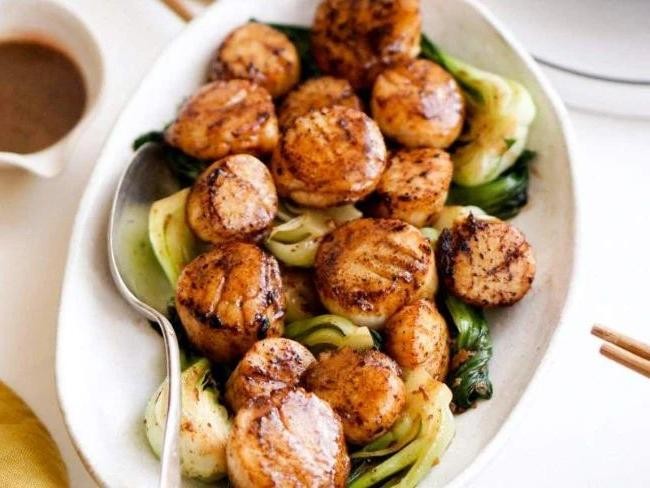
Often, in the quiet of the evening, I find myself drawn to the simplicity of the sea, to the gentle sweetness of scallops that carry the ocean’s whisper. On evenings like these, I let a dollop of white miso and a generous pat of butter work their quiet magic, transforming the humble scallop into something softly profound. It’s a dish that feels like a slow, deep breath—a moment of calm in a bustling world.
2
servings10
minutes5
minutesIngredients
– 12 large, dry-packed sea scallops
– 2 tablespoons unsalted European-style butter
– 1 tablespoon smooth white miso paste
– 1 tablespoon rich extra virgin olive oil
– 1 small, finely minced garlic clove
– 1 teaspoon freshly squeezed lemon juice
– 1 tablespoon thinly sliced fresh chives
– 1/4 teaspoon finely ground black pepper
– 1/4 teaspoon flaky sea salt
Instructions
1. Pat the 12 large, dry-packed sea scallops completely dry with paper towels to ensure a golden sear.
2. Season both sides of the scallops evenly with 1/4 teaspoon flaky sea salt and 1/4 teaspoon finely ground black pepper.
3. Heat 1 tablespoon rich extra virgin olive oil in a large stainless steel skillet over medium-high heat until it shimmers, about 2 minutes.
4. Place the scallops in the skillet, leaving space between them, and sear undisturbed for 2 minutes until a deep golden crust forms.
5. Flip each scallop carefully with tongs and cook for 1 more minute until just opaque and firm to the touch.
6. Transfer the scallops to a warm plate, reducing the skillet heat to low.
7. Add 2 tablespoons unsalted European-style butter to the skillet, swirling until melted and lightly foaming.
8. Stir in 1 tablespoon smooth white miso paste and 1 small, finely minced garlic clove, cooking for 30 seconds until fragrant.
9. Remove the skillet from heat and whisk in 1 teaspoon freshly squeezed lemon juice to create a glossy sauce.
10. Return the scallops to the skillet, gently tossing to coat in the miso butter sauce.
11. Sprinkle with 1 tablespoon thinly sliced fresh chives just before serving.
Finally, the scallops emerge tender and yielding, their delicate sweetness deepened by the umami-rich miso and brown butter. Serve them nestled over a bed of creamy polenta or alongside crisp-tipped asparagus for a meal that feels both elegant and effortlessly comforting.
White Miso and Mushroom Risotto
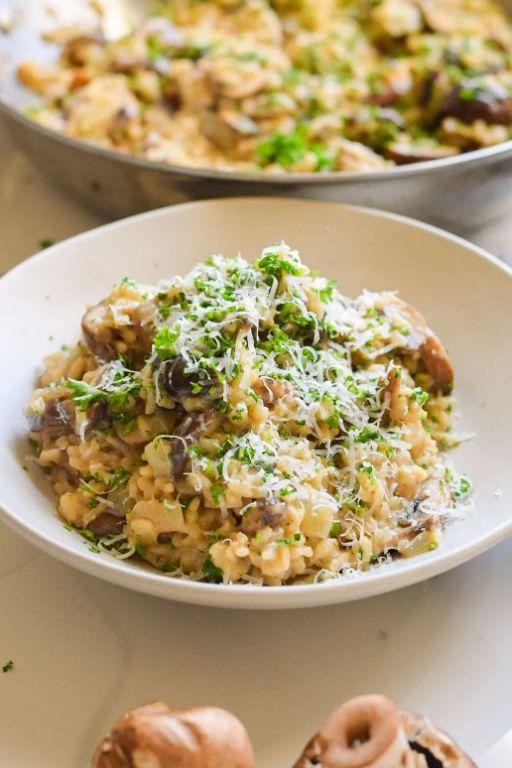
Mellow autumn afternoons like this make me crave something deeply comforting yet quietly sophisticated, a dish that unfolds slowly like the changing leaves outside my window. This white miso and mushroom risotto feels like a gentle embrace in a bowl, where earthy mushrooms meet the subtle umami of miso in a creamy, thoughtful dance.
2
servings15
minutes35
minutesIngredients
– 1 cup Arborio rice
– 8 ounces mixed wild mushrooms, thinly sliced
– 1 large shallot, finely minced
– 3 tablespoons unsalted butter, divided
– 1 tablespoon extra virgin olive oil
– 1/2 cup dry white wine
– 4 cups warm vegetable broth
– 2 tablespoons white miso paste
– 1/4 cup freshly grated Parmesan cheese
– 2 tablespoons chopped fresh parsley
Instructions
1. Heat 1 tablespoon butter and olive oil in a heavy-bottomed pot over medium heat until butter melts and foams slightly.
2. Add minced shallot and cook for 3-4 minutes until translucent and fragrant, stirring frequently to prevent browning.
3. Add sliced mushrooms and cook for 6-8 minutes until they release their liquid and develop golden edges.
4. Stir in Arborio rice and toast for 2 minutes, coating each grain in the butter mixture until slightly translucent around the edges.
5. Pour in white wine and cook while stirring constantly until completely absorbed, about 2 minutes.
6. Add 1/2 cup warm vegetable broth and stir continuously until liquid is nearly absorbed.
7. Continue adding broth 1/2 cup at a time, stirring constantly and waiting until each addition is mostly absorbed before adding the next – this gradual process should take about 18-20 minutes total.
8. When rice is al dente and creamy but still has slight bite, remove from heat and let rest for 1 minute.
9. Whisk white miso paste with 2 tablespoons of the remaining warm broth in a small bowl until smooth.
10. Stir miso mixture, remaining 2 tablespoons butter, and Parmesan cheese into the risotto until creamy and well incorporated.
11. Fold in chopped parsley just before serving.
A perfect risotto should flow slowly when spooned, with each grain maintaining its individual character while contributing to the overall creaminess. The white miso adds a subtle saltiness that enhances the earthy mushrooms without overpowering them. For a beautiful presentation, top with extra parsley and shaved Parmesan, perhaps alongside roasted autumn vegetables or simply enjoyed in a deep bowl with nothing but quiet appreciation.
Sesame and White Miso Cold Noodles
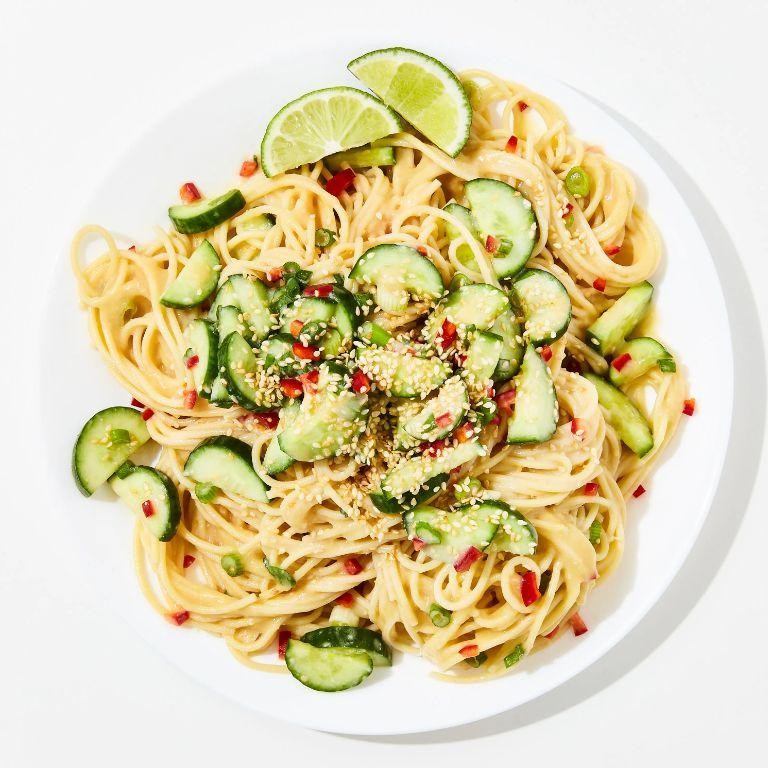
There’s something quietly comforting about the way summer light filters through kitchen windows, settling on countertops where simple ingredients wait to transform into something greater than their parts. This dish captures that peaceful transition from afternoon warmth to evening cool, a gentle bridge between seasons in a bowl.
5
servings15
minutes4
minutesIngredients
– 8 ounces thin wheat noodles
– 3 tablespoons creamy white miso paste
– 2 tablespoons toasted sesame oil
– 1 tablespoon rich soy sauce
– 1 teaspoon fragrant rice vinegar
– 1 teaspoon golden honey
– 2 cloves freshly minced garlic
– 1 teaspoon finely grated ginger root
– 2 thinly sliced scallions
– 1 tablespoon toasted sesame seeds
– Fresh cilantro leaves for garnish
Instructions
1. Bring 4 quarts of water to a rolling boil in a large pot.
2. Add 8 ounces of thin wheat noodles and cook for exactly 4 minutes, stirring occasionally to prevent sticking.
3. Drain noodles immediately and rinse under cold running water for 2 full minutes until completely cool to the touch.
4. Shake the colander vigorously to remove excess water, then transfer noodles to a large mixing bowl.
5. In a small bowl, whisk together 3 tablespoons of creamy white miso paste and 2 tablespoons of toasted sesame oil until smooth and emulsified.
6. Add 1 tablespoon of rich soy sauce, 1 teaspoon of fragrant rice vinegar, and 1 teaspoon of golden honey to the miso mixture, whisking continuously.
7. Stir in 2 cloves of freshly minced garlic and 1 teaspoon of finely grated ginger root until fully incorporated.
8. Pour the dressing over the cooled noodles and toss gently with tongs until every strand is evenly coated.
9. Let the noodles rest at room temperature for 15 minutes to allow flavors to meld.
10. Sprinkle with 2 thinly sliced scallions and 1 tablespoon of toasted sesame seeds.
11. Garnish generously with fresh cilantro leaves just before serving.
Zesty garlic and ginger play against the deep umami of miso, while the chilled noodles provide the perfect slippery texture that makes each bite both refreshing and substantial. Try serving these in shallow bowls with extra sesame seeds scattered across the top, or pack them cold for a picnic where they’ll taste even better after the flavors have had time to deepen and settle together.
White Miso and Lime Vinaigrette Salad
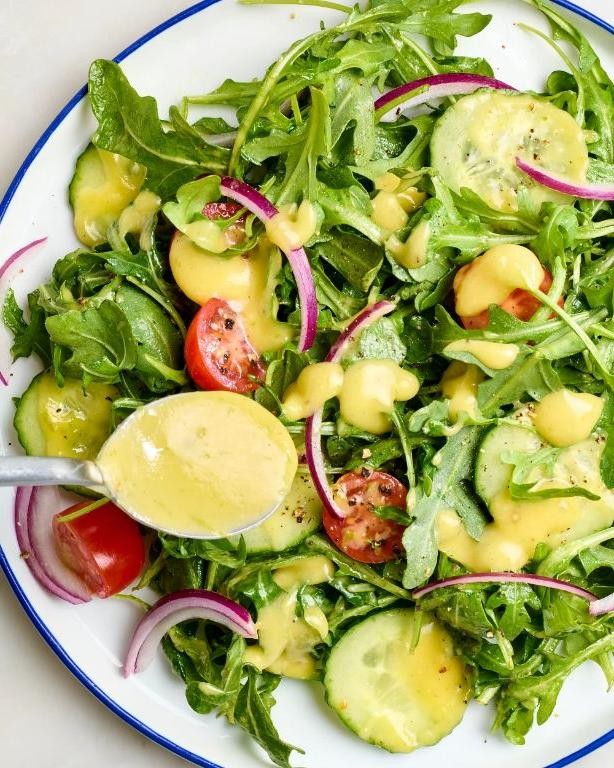
Mornings like this, when the light falls just so through the kitchen window, I find myself reaching for the quiet comfort of making a dressing, of building a salad from the ground up, piece by gentle piece. There’s a particular peace in the ritual of it, in the slow whisking and the careful tasting, a small meditation before the meal itself. Today, it’s a vinaigrette of white miso and lime that calls to me, a blend of earthy depth and bright, waking citrus.
5
servings15
minutesIngredients
– 1/4 cup fresh lime juice from 2-3 plump, juicy limes
– 3 tablespoons smooth, savory white miso paste
– 2 tablespoons rich, golden extra virgin olive oil
– 1 tablespoon raw, wildflower honey
– 1 small garlic clove, finely minced to a fragrant paste
– 6 cups crisp, fresh romaine lettuce, torn into bite-sized pieces
– 1/2 cup sweet, crunchy cherry tomatoes, halved
– 1/4 cup thinly sliced, pungent red onion
Instructions
1. In a medium glass bowl, combine the fresh lime juice and smooth white miso paste.
2. Whisk the mixture vigorously for 60 seconds until the miso is fully dissolved and the liquid is smooth with no lumps. (Tip: Using a glass bowl lets you see if any miso paste is stuck to the bottom, ensuring a perfectly emulsified base.)
3. Slowly drizzle in the golden extra virgin olive oil while continuously whisking to create a stable, lightly thickened emulsion.
4. Whisk in the raw wildflower honey and the finely minced garlic paste until the dressing is completely uniform.
5. Place the crisp romaine lettuce, halved cherry tomatoes, and thinly sliced red onion in a large salad bowl.
6. Pour the prepared vinaigrette over the salad ingredients.
7. Using clean hands or salad tongs, gently toss the salad for 30-45 seconds, ensuring every leaf is lightly and evenly coated with the dressing. (Tip: Tossing with your hands allows you to feel the dressing distribute without bruising the delicate lettuce.)
8. Let the dressed salad rest at room temperature for 5 minutes before serving to allow the flavors to meld and the lettuce to slightly soften. (Tip: This brief rest period allows the acidic dressing to gently wilt the greens just enough for a more integrated flavor, without making them soggy.)
Heirloom tomatoes would add a beautiful color variation, or a sprinkle of toasted sesame seeds for a subtle crunch. The final texture is a wonderful contrast—the lettuce remains crisp but yielding, while the vinaigrette clings to each leaf with its creamy, tangy, and subtly sweet character. It’s a salad that feels both nourishing and light, a quiet celebration of simple, clean flavors.
White Miso Glazed Eggplant
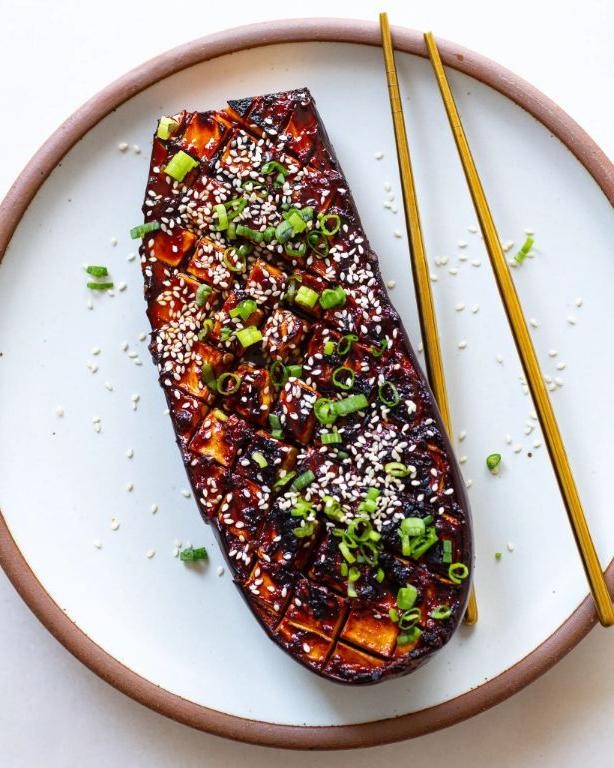
Just now, standing in my quiet kitchen with the afternoon light softening, I found myself reaching for the deep purple eggplants, remembering how their silken texture transforms beneath a sweet-savory glaze. There’s something quietly comforting about this dish, a gentle hum of umami that feels like a slow, deep breath after a long day.
2
portions15
minutes37
minutesIngredients
– 2 medium firm, glossy eggplants
– 3 tablespoons smooth white miso paste
– 2 tablespoons rich maple syrup
– 1 tablespoon toasted sesame oil
– 1 tablespoon fresh, zesty lime juice
– 2 cloves aromatic garlic, finely minced
– 1 teaspoon freshly grated ginger root
– 1 tablespoon cool water
– 2 tablespoons vibrant chopped scallions
– 1 teaspoon nutty toasted sesame seeds
Instructions
1. Preheat your oven to 400°F and line a baking sheet with parchment paper.
2. Slice each eggplant in half lengthwise, then score the flesh in a crosshatch pattern about ½-inch deep without cutting through the skin.
3. Brush the scored eggplant flesh evenly with the toasted sesame oil, ensuring it seeps into the cuts.
4. Place the eggplant halves cut-side up on the prepared baking sheet and roast for 25 minutes until the flesh is tender and lightly golden.
5. While the eggplant roasts, whisk together the white miso paste, maple syrup, lime juice, minced garlic, grated ginger, and water in a small bowl until completely smooth.
6. Remove the baking sheet from the oven and carefully spoon the miso glaze evenly over the tender eggplant halves, spreading it to cover the scored surfaces completely.
7. Return the glazed eggplant to the oven and roast for an additional 10-12 minutes until the glaze is bubbling and caramelized at the edges.
8. Transfer the finished eggplant to a serving platter and immediately sprinkle with the chopped scallions and toasted sesame seeds while still hot.
Resting on the plate, the eggplant yields to the fork with a custard-like softness, its edges crisped by the sweet glaze that pools in the scored grooves. I love serving it over a bed of jasmine rice to catch every drop of the savory-sweet sauce, or tucked into a bowl with steamed greens for a simple, nourishing meal.
White Miso and Carrot Puree
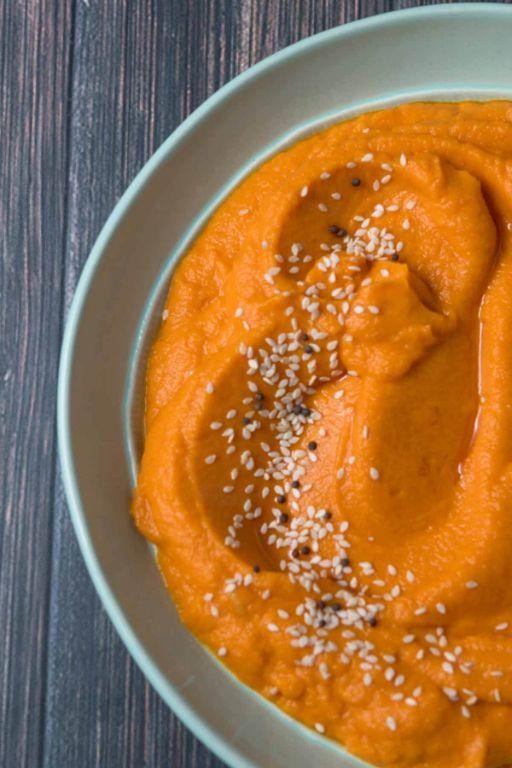
Under the soft afternoon light, I find myself drawn to the quiet simplicity of root vegetables, their earthy sweetness offering a gentle comfort that feels both nourishing and deeply personal. This white miso and carrot puree emerged from such a moment, a humble yet soulful creation that transforms everyday ingredients into something quietly extraordinary.
2
servings10
minutes18
minutesIngredients
– 1 pound of sweet, vibrant orange carrots
– 3 tablespoons of savory white miso paste
– 2 tablespoons of rich extra virgin olive oil
– 1/4 cup of cool filtered water
– 1/2 teaspoon of finely ground sea salt
– 1 tablespoon of freshly squeezed lemon juice
Instructions
1. Peel 1 pound of sweet, vibrant orange carrots and slice them into uniform 1/2-inch rounds to ensure even cooking.
2. Place the carrot rounds in a medium saucepan and add just enough water to cover them completely.
3. Bring the water to a boil over high heat, then reduce to a simmer and cook for 15–18 minutes until the carrots are fork-tender but not mushy.
4. Drain the carrots thoroughly in a colander, gently shaking to remove excess moisture that could dilute the puree.
5. Transfer the warm carrots to a high-speed blender or food processor.
6. Add 3 tablespoons of savory white miso paste, 2 tablespoons of rich extra virgin olive oil, 1/4 cup of cool filtered water, 1/2 teaspoon of finely ground sea salt, and 1 tablespoon of freshly squeezed lemon juice.
7. Blend on medium speed for 45–60 seconds until completely smooth, scraping down the sides once to incorporate any stubborn bits.
8. Taste and adjust seasoning if needed, keeping in mind the miso already contributes saltiness.
9. Transfer the puree to a serving bowl and let it rest for 5 minutes to allow the flavors to meld.
Mellow and velvety in texture, this puree carries the gentle umami of miso balanced by the carrots’ natural sweetness. I love serving it warm alongside roasted chicken or spreading it thickly on crusty bread, where its creamy consistency and subtle complexity truly shine.
Spaghetti with White Miso and Lemon Sauce
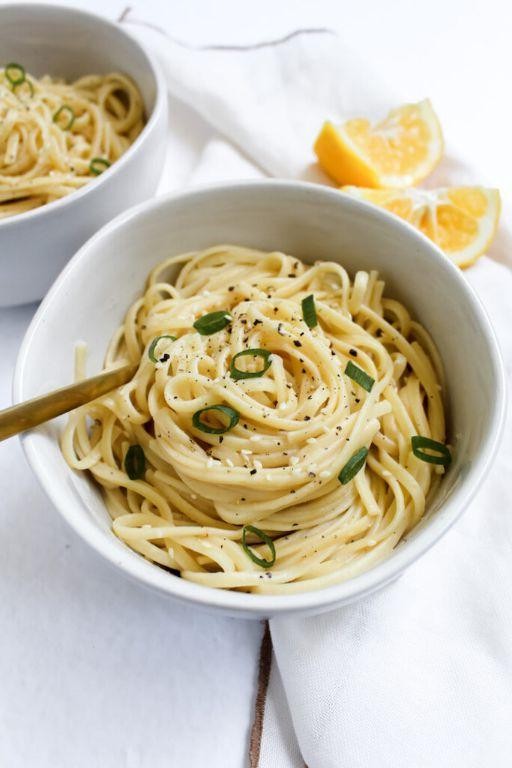
Perhaps there are days when the kitchen calls for something quietly transformative, a meal that feels both comforting and gently surprising. This spaghetti with white miso and lemon sauce is exactly that—a simple yet soulful dish where familiar pasta meets the subtle umami of miso and the bright lift of citrus, creating something quietly special on an ordinary evening.
2
servings10
minutes15
minutesIngredients
- 8 ounces dried spaghetti
- 2 tablespoons rich extra virgin olive oil
- 3 cloves fragrant garlic, thinly sliced
- 2 tablespoons smooth white miso paste
- 1 juicy lemon, zested and juiced
- 1/4 cup freshly grated Parmesan cheese
- 2 tablespoons chopped fresh parsley
- 1/4 teaspoon finely ground black pepper
- 1/4 cup reserved starchy pasta water
Instructions
- Bring a large pot of salted water to a rolling boil over high heat.
- Add 8 ounces dried spaghetti and cook for 9–11 minutes, stirring occasionally, until al dente (tender but with a slight bite).
- Reserve 1/4 cup of the starchy pasta water, then drain the spaghetti in a colander.
- Heat 2 tablespoons rich extra virgin olive oil in a large skillet over medium-low heat.
- Add 3 cloves thinly sliced fragrant garlic and sauté for 1–2 minutes, until fragrant but not browned.
- Whisk 2 tablespoons smooth white miso paste into the skillet until fully incorporated with the oil and garlic.
- Tip: If the miso sticks, add a splash of reserved pasta water to help it emulsify smoothly.
- Add the drained spaghetti to the skillet, tossing to coat evenly with the miso mixture.
- Pour in the juice of 1 juicy lemon and 1/4 cup reserved starchy pasta water, tossing continuously.
- Tip: The starchy water helps the sauce cling to each strand of pasta.
- Sprinkle in 1/4 cup freshly grated Parmesan cheese, 2 tablespoons chopped fresh parsley, and 1/4 teaspoon finely ground black pepper, tossing until the cheese melts and the sauce lightly coats the spaghetti.
- Remove from heat and stir in the zest of 1 juicy lemon.
- Tip: Adding lemon zest off-heat preserves its bright, aromatic oils.
Lightly creamy from the miso and Parmesan, each forkful carries the gentle tang of lemon and the earthy depth of garlic. Serve it in shallow bowls with an extra sprinkle of parsley, or alongside a simple green salad to let its nuanced flavors shine.
White Miso and Honey Glazed Carrots

Mellow autumn afternoons like this one always draw me to the kitchen, where simple ingredients can transform into something quietly extraordinary. There’s something deeply comforting about roasting vegetables, watching them caramelize and soften into tender, sweet bites that feel like a gentle embrace. Today, I’m making white miso and honey glazed carrots—a dish that balances earthy sweetness with a hint of umami, perfect for slow, reflective cooking.
2
servings15
minutes35
minutesIngredients
– 1 pound fresh, slender carrots with vibrant orange skins
– 2 tablespoons smooth white miso paste
– 1 tablespoon raw, golden honey
– 1 tablespoon rich extra virgin olive oil
– 1/2 teaspoon finely ground black pepper
– 1/4 cup cool, filtered water
– 1 tablespoon freshly squeezed lemon juice
Instructions
1. Preheat your oven to 400°F and line a baking sheet with parchment paper for easy cleanup.
2. Scrub the fresh, slender carrots thoroughly under running water to remove any dirt, then pat them completely dry with a clean kitchen towel.
3. Trim off the carrot tops and slice the carrots on a sharp diagonal into 1/2-inch thick pieces for even roasting.
4. In a medium mixing bowl, whisk together the smooth white miso paste, raw golden honey, and rich extra virgin olive oil until fully combined and glossy.
5. Add the sliced carrots to the bowl and toss them gently with a rubber spatula until each piece is evenly coated with the glaze.
6. Spread the glazed carrots in a single layer on the prepared baking sheet, ensuring they aren’t crowded to allow for proper caramelization.
7. Roast the carrots in the preheated oven for 20 minutes, then rotate the baking sheet 180 degrees for even browning.
8. After 20 minutes, carefully remove the baking sheet from the oven and drizzle the carrots with the cool, filtered water to prevent drying.
9. Return the carrots to the oven and continue roasting for another 10-15 minutes, until the edges are deeply golden and caramelized.
10. Remove the baking sheet from the oven and immediately sprinkle the carrots with finely ground black pepper.
11. Drizzle the freshly squeezed lemon juice over the hot carrots, tossing gently to combine all the flavors.
12. Let the carrots rest for 5 minutes on the baking sheet to allow the glaze to set slightly before serving. They emerge tender yet firm, with a glossy sheen that hints at their sweet-savory depth. Try scattering them over a bed of creamy polenta or alongside seared salmon for a meal that feels both rustic and refined.
White Miso Pesto Pasta
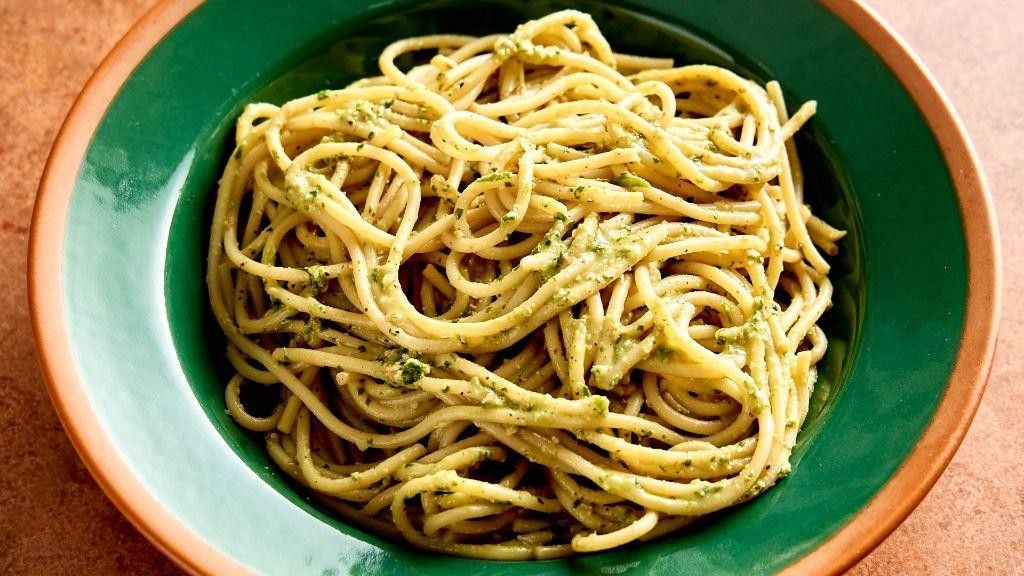
Kind of like finding an old photograph you forgot you’d taken, this pasta recipe surfaced during one of those quiet evenings when the kitchen becomes more sanctuary than workspace. There’s something about the gentle umami of white miso meeting the familiar comfort of pesto that feels both new and deeply known. It’s the sort of dish that asks you to slow down, to notice how ingredients transform when given proper attention.
2
portions10
minutes11
minutesIngredients
- 8 ounces dried linguine pasta
- 3 tablespoons rich white miso paste
- 1/2 cup fragrant basil leaves, tightly packed
- 1/4 cup nutty pine nuts
- 2 cloves aromatic garlic, peeled
- 1/3 cup fruity extra virgin olive oil
- 1/4 cup finely grated Parmesan cheese
- 2 tablespoons fresh lemon juice
- 1/4 teaspoon flaky sea salt
Instructions
- Bring 4 quarts of water to a rolling boil in a large stockpot over high heat.
- Add 1 tablespoon of salt to the boiling water, then carefully add the dried linguine pasta, stirring immediately to prevent sticking.
- Cook the pasta for 9-11 minutes, stirring occasionally, until it reaches al dente texture with a slight firmness when bitten.
- While pasta cooks, combine fragrant basil leaves, nutty pine nuts, and aromatic garlic in a food processor, pulsing 5-7 times until coarsely chopped.
- Add rich white miso paste, fruity extra virgin olive oil, and fresh lemon juice to the food processor, then blend for 30 seconds until a smooth, emulsified sauce forms.
- Transfer the miso pesto to a large mixing bowl and stir in finely grated Parmesan cheese until fully incorporated.
- Reserve 1/2 cup of the starchy pasta water before draining the cooked linguine.
- Immediately add the hot drained pasta to the mixing bowl with the miso pesto, tossing vigorously with tongs to coat every strand.
- Gradually add 2-3 tablespoons of the reserved pasta water, continuing to toss until the sauce becomes creamy and clings to the pasta.
- Season with flaky sea salt, then divide between two warmed pasta bowls.
During those first bites, you’ll notice how the silky sauce clings to each strand of pasta, creating a luxurious texture that’s neither heavy nor thin. The white miso brings a subtle depth that makes the basil taste brighter, the pine nuts toastier, the entire dish more complex than ordinary pesto. Try serving it alongside roasted cherry tomatoes that burst with sweetness, or top with delicate shavings of Parmesan for contrasting texture.
Sweet White Miso Marinade for Pork
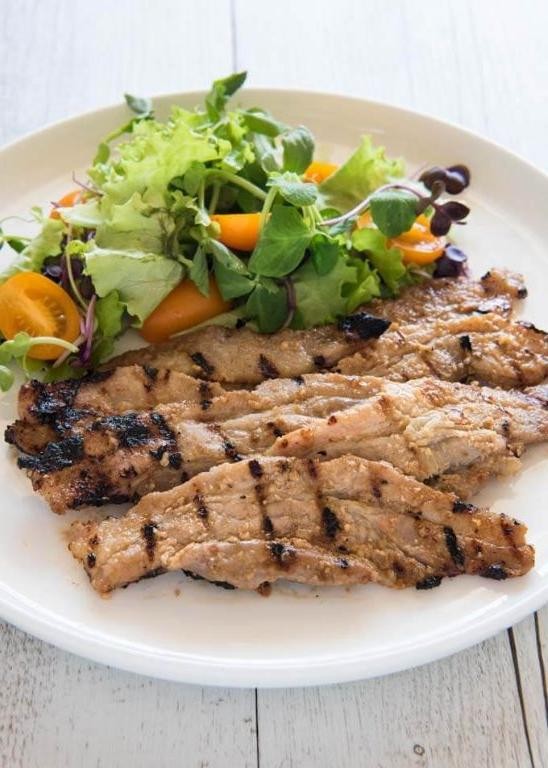
Wandering through the quiet kitchen this afternoon, I found myself reaching for that familiar ceramic bowl, the one that holds memories of meals past. There’s something deeply comforting about preparing this sweet white miso marinade, a gentle ritual that transforms simple pork into something extraordinary, like a quiet conversation with ingredients that know they’re about to become something beautiful.
2
servings15
minutes25
minutesIngredients
– ½ cup sweet white miso paste, smooth and ivory-colored
– ¼ cup mirin, with its delicate sweetness
– 2 tablespoons soy sauce, dark and richly savory
– 1 tablespoon toasted sesame oil, fragrant and nutty
– 2 teaspoons fresh ginger, finely grated and aromatic
– 1 large garlic clove, minced to release its pungent warmth
– 1½ pounds pork tenderloin, trimmed of silver skin
Instructions
1. Combine ½ cup sweet white miso paste, ¼ cup mirin, 2 tablespoons soy sauce, and 1 tablespoon toasted sesame oil in a medium mixing bowl.
2. Whisk the mixture vigorously for 45 seconds until completely smooth and well-emulsified.
3. Stir in 2 teaspoons finely grated fresh ginger and 1 minced garlic clove until evenly distributed throughout the marinade.
4. Place 1½ pounds pork tenderloin in a gallon-sized resealable plastic bag or shallow baking dish.
5. Pour the complete marinade over the pork, ensuring all surfaces are thoroughly coated.
6. Press out excess air from the bag if using, then seal tightly.
7. Refrigerate the marinating pork for exactly 8 hours, turning the bag over once halfway through for even flavor penetration.
8. Remove the pork from refrigerator 30 minutes before cooking to bring it to room temperature for even cooking.
9. Preheat your oven to 400°F and position the rack in the center of the oven.
10. Scrape excess marinade from the pork surface, reserving 2 tablespoons for basting.
11. Place the pork on a wire rack set inside a rimmed baking sheet to allow air circulation.
12. Roast the pork at 400°F for 22-25 minutes until the internal temperature reaches 145°F when measured with an instant-read thermometer inserted into the thickest part.
13. Baste the pork with reserved marinade every 8 minutes during roasting to build a glossy, caramelized crust.
14. Transfer the pork to a cutting board and let it rest undisturbed for 8 minutes to allow juices to redistribute.
15. Slice the pork against the grain into ½-inch thick medallions using a sharp carving knife.
Something magical happens when the sweet miso caramelizes against the pork’s surface, creating a delicate crust that gives way to impossibly tender flesh beneath. The gentle umami sweetness pairs beautifully with steamed jasmine rice that soaks up the savory juices, or try slicing it thin to top a vibrant salad of bitter greens for contrast.
White Miso Roasted Cauliflower
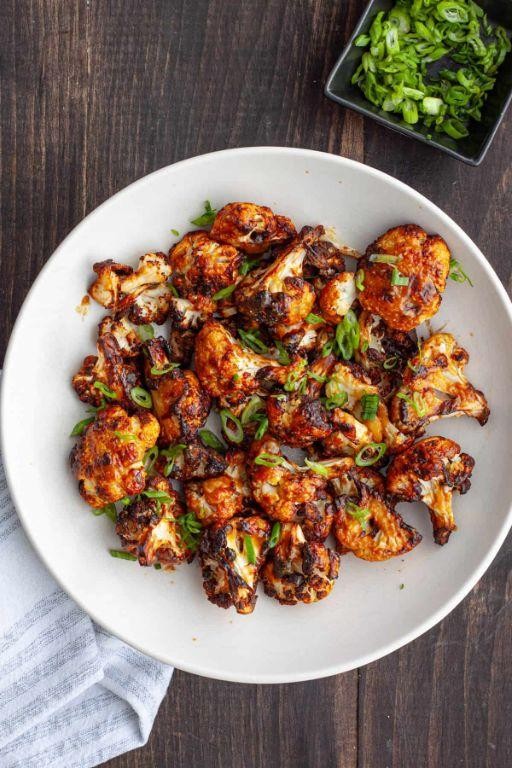
Holding this warm bowl of roasted cauliflower, I’m reminded how the simplest vegetables can transform into something deeply comforting when given patience and care. The gentle umami of white miso wraps each floret in a savory embrace that feels both nourishing and quietly celebratory. Sometimes the most satisfying meals emerge from these unhurried moments in the kitchen.
5
servings15
minutes40
minutesIngredients
– 1 large head of fresh cauliflower, cut into bite-sized florets
– 3 tablespoons of smooth white miso paste
– 2 tablespoons of rich extra virgin olive oil
– 1 tablespoon of pure maple syrup
– 1 tablespoon of fresh lemon juice
– 2 cloves of aromatic garlic, minced
– 1 teaspoon of toasted sesame oil
– ½ teaspoon of finely ground black pepper
– 2 tablespoons of toasted sesame seeds for garnish
– 2 tablespoons of freshly chopped scallions for garnish
Instructions
1. Preheat your oven to 425°F and line a large baking sheet with parchment paper.
2. In a medium mixing bowl, whisk together the white miso paste, olive oil, maple syrup, lemon juice, minced garlic, sesame oil, and black pepper until completely smooth.
3. Add the cauliflower florets to the bowl and toss gently until every piece is evenly coated with the miso mixture.
4. Spread the coated cauliflower in a single layer on the prepared baking sheet, ensuring pieces aren’t touching for optimal browning.
5. Roast for 20-25 minutes, then flip each piece carefully using tongs to ensure even caramelization on all sides.
6. Continue roasting for another 10-15 minutes until the edges are deeply golden brown and the florets are tender when pierced with a fork.
7. Remove from oven and immediately transfer to a serving platter.
8. Sprinkle generously with toasted sesame seeds and fresh scallions while still warm.
When the cauliflower emerges from the oven, the edges become crisp and caramelized while the centers remain tender, creating a beautiful textural contrast. The white miso lends a subtle saltiness that balances perfectly with the maple syrup’s gentle sweetness, making this versatile enough to serve as either a standout side or piled high over grains for a satisfying vegetarian main.
Conclusion
Embrace the versatility of white miso with these 27 delicious recipes! From soups to marinades, there’s something for every home cook to enjoy. We hope you find new favorites—give them a try, leave a comment sharing which ones you love, and don’t forget to pin this roundup on Pinterest for later. Happy cooking!
